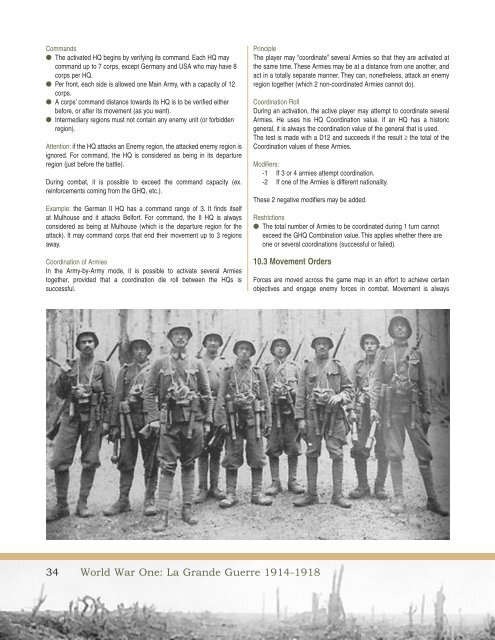You also want an ePaper? Increase the reach of your titles
YUMPU automatically turns print PDFs into web optimized ePapers that Google loves.
Commands<br />
● The activated HQ begins by verifying its command. Each HQ may<br />
command up to 7 corps, except Germany and USA who may have 8<br />
corps per HQ.<br />
● Per front, each side is allowed one Main Army, with a capacity of 12<br />
corps.<br />
● A corps’ command distance towards its HQ is to be verified either<br />
before, or after its movement (as you want).<br />
● Intermediary regions must not contain any enemy unit (or forbidden<br />
region).<br />
Attention: if the HQ attacks an Enemy region, the attacked enemy region is<br />
ignored. For command, the HQ is considered as being in its departure<br />
region (just before the battle).<br />
During combat, it is possible to exceed the command capacity (ex.<br />
reinforcements coming from the GHQ, etc.).<br />
Example: the German II HQ has a command range of 3. It finds itself<br />
at Mulhouse and it attacks Belfort. For command, the II HQ is always<br />
considered as being at Mulhouse (which is the departure region for the<br />
attack). It may command corps that end their movement up to 3 regions<br />
away.<br />
Coordination of Armies<br />
In the Army-by-Army mode, it is possible to activate several Armies<br />
together, provided that a coordination die roll between the HQs is<br />
successful.<br />
34 World War One: La Grande Guerre 1914-1918<br />
Principle<br />
The player may “coordinate” several Armies so that they are activated at<br />
the same time. These Armies may be at a distance from one another, and<br />
act in a totally separate manner. They can, nonetheless, attack an enemy<br />
region together (which 2 non-coordinated Armies cannot do).<br />
Coordination Roll<br />
During an activation, the active player may attempt to coordinate several<br />
Armies. He uses his HQ Coordination value. If an HQ has a historic<br />
general, it is always the coordination value of the general that is used.<br />
The test is made with a D12 and succeeds if the result ≥ the total of the<br />
Coordination values of these Armies.<br />
Modifiers:<br />
-1 If 3 or 4 armies attempt coordination.<br />
-2 If one of the Armies is different nationality.<br />
These 2 negative modifiers may be added.<br />
Restrictions<br />
● The total number of Armies to be coordinated during 1 turn cannot<br />
exceed the GHQ Combination value. This applies whether there are<br />
one or several coordinations (successful or failed).<br />
10.3 Movement Orders<br />
Forces are moved across the game map in an effort to achieve certain<br />
objectives and engage enemy forces in combat. Movement is always
















